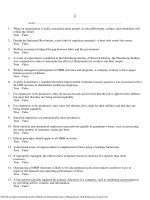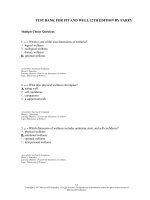Download test bank for society the basics 12th edition by macionis
Bạn đang xem bản rút gọn của tài liệu. Xem và tải ngay bản đầy đủ của tài liệu tại đây (243 KB, 41 trang )
Test Bank For Society The Basics 12th Edition
by Macionis
Link download full: />
CHAPTER 2: CULTURE
TRUE/FALSE QUESTIONS
1.
Businesses in this country can profit from recognizing the cultural diversity of
the U.S. population.
(REMEMBER; answer: T; page 36)
2.
People around the world have much the same outward appearance and wear
the same clothing and bodily decoration.
(REMEMBER; answer: F; page 36)
3.
Culture is the ways of thinking, ways of acting, and material objects that
together form a people’s way of life.
(REMEMBER; answer: T; page 36)
4.
An example of nonmaterial culture would be the types of vehicles people use
to get around.
(UNDERSTAND; answer: F; pages 36-37)
5.
Experiencing an unfamiliar culture can generate culture shock.
(UNDERSTAND; answer: T; page 38)
6.
The same way of life is “natural” to humans everywhere.
(REMEMBER; answer: F; page 38)
7.
The Census Bureau reports that only ten different languages are spoken in the
United States.
(REMEMBER; answer: F; page 39)
8.
For at least 12,000 years, humans have used culture as a strategy for survival.
REMEMBER; answer: T; page 39)
9.
Symbols refer to anything that carries meaning that is recognized by people
who share a culture.
(REMEMBER; answer: T; page 40)
10. The emergence of computer-based instant messaging shows how new symbols
are being created all the time.
(APPLY; answer: T; page 40)
11. The story of Helen Keller, who became blind and deaf, shows how the
development of our humanity depends on the ability to understand and use
symbols.
(APPLY; answer: T; page 40)
12. Understanding symbols allows people to make sense of their surroundings.
3
(UNDERSTAND; answer: T; page 40)
13. The gesture we commonly call “thumbs up” is used in most of the world’s
societies to signify that something is very good. (REMEMBER; answer: F;
page 41)
14. Cultural transmission cannot take place unless people have a written language.
(UNDERSTAND; answer: F; page 41)
15. All written languages are intended to be read from left to right.
(REMEMBER; answer: F; page 41)
16. The Sapir-Whorf thesis states that the language we use shapes the reality we
perceive.
(REMEMBER; answer: T; page 41)
17. Values are standards that serve as broad guidelines for social living.
(REMEMBER; answer: T; page 41)
18. English is the first language of only 5% of humanity, but it has become the
preferred second language throughout most of the world.
(REMEMBER; answer: T; page 42)
19. Most people in the United States share the value that everyone should not only
have equality of opportunity, but also equality in all aspects of social standing.
(UNDERSTAND; answer: F; pages 42-43)
20. People in the United States tend to view the past as being better than the
present.
(REMEMBER; answer: F; page 43)
21. One emerging value in the United States is the importance of personal growth,
including spiritual activity.
(REMEMBER; answer: T; page 43)
22. Cultural values in the United States always go together—they are all consistent
with one another.
(UNDERSTAND; answer: F; page 43)
23. In general, low-income nations have cultures that value individualism and
personal self- expression.
(UNDERSTAND; answer: F; pages 43-44)
24. Compared to cultures around the world, the way of life in the United States
emphasizes individualism.
(UNDERSTAND; answer: T; page 44)
4
25. Cultural values in high-income nations tend to be secular and rational, giving
greater importance to personal self-expression.
(UNDERSTAND; answer: T; page 44)
26. Mores are norms that have great moral significance.
(REMEMBER; answer: T; page 44)
27. Across the United States, mores vary more than folkways.
(REMEMBER; answer: F; page 44)
28. Values and norms help to define a society’s “ideal culture.”
(REMEMBER; answer: T; page 44)
29. Technology refers to knowledge people use to make a way of life in their
surroundings.
(REMEMBER; answer: T; page 45)
30. Japan is more multicultural than the United States.
(REMEMBER; answer: F; page 47)
31. The U.S. has a popular culture, but not a high culture.
(REMEMBER; answer: F; pages 47-48)
32. Most people participate in numerous subcultures without necessarily becoming
very committed to any of them.
(REMEMBER; answer: T; page 48)
33. Multiculturalists claim that, over the course of U.S. history, most non-English
immigrants
were advised to adopt the cultural patterns of the English—their “betters”—rather
than
“melt in.”
(UNDERSTAND; answer: T; page 48)
34. Subculture is more at odds with dominant culture than counterculture.
(UNDERSTAND; answer: F; pages 48-49)
35. Afrocentrism refers to the dominance of European cultural patterns.
(REMEMBER; answer: F; page 49)
36. Cultural lag refers to the fact that some cultural elements change more quickly
than others.
(REMEMBER; answer: T; page 50)
37. Cultural change results from invention, discovery, and diffusion.
(REMEMBER; answer: T; pages 50-51)
38. Cultural relativism means using your own cultural standards to evaluate
another culture.
(REMEMBER; answer: F; page 51)
5
39. Rock-and-roll music in the United States is one cultural trait that has nothing in
common with music that was popular a short time before it emerged.
(REMEMBER; answer: F; page 52)
40. The structural-functional approach sees culture as a relatively stable system of
integrated patterns people use to meet their needs.
(UNDERSTAND; answer: T; page 54)
6
41. The Amish way of life accepts most of the U.S.’s popular culture.
(REMEMBER; answer: F; page 54)
42. Cultural universals refer to patterns that are held by everyone in a society.
(REMEMBER; answer: F; page 54)
43. Karl Marx argued that a society’s economic system was shaped by its value
system.
(REMEMBER; answer: F; page 54)
44. Sociobiology explores how human biology has shaped today’s culture.
(REMEMBER; answer: T; page 55)
45. It is fair to say that humans are prisoners of their existing culture.
(UNDERSTAND; answer: F; pages 56-57)
MULTIPLE-CHOICE QUESTIONS
46. The chapter’s opening story of the diversity initiative at Charles Schwab & Co.
shows us that
a. various minorities respond to the same advertising in exactly the same way.
b. Asian American immigrants prefer English to their native language when they
are doing business.
c. learning more about cultural diversity can help a company boost sales.
d. All of these responses are correct.
(REMEMBER; answer: c; page 36)
47. The United States is the most _______ of all countries.
a.
multicultural
b.
culturally uniform
c.
slowly changing
d.
nonmaterial
(REMEMBER; answer: a; page 36)
48. What is the term for the ways of thinking, ways of acting, and material objects
that together form a people’s way of life? a.
b.
social system
c.
culture
d.
society
social structure
(REMEMBER; answer: c; page 36)
7
49.
The United States is multicultural because
a.
everyone holds the same values and beliefs.
b.
each individual holds many different and conflicting values and beliefs.
c.
there are many widely shared values and beliefs.
d.
in this country we find many different languages and ways of life.
(REMEMBER; answer: d; page 36)
50. As a part of human culture, religion is an example of
a.
material culture.
b.
nonmaterial culture.
c.
culture shock.
d.
human nature.
(APPLY; answer: b; pages 36-37)
51. The intangible world of ideas created by members of a society is referred to as
a.
high culture.
b.
material culture.
c.
norms.
d.
nonmaterial culture.
(REMEMBER; answer: d; pages 36-37)
52. Cars, computers, and iPhones are all examples of which of the following?
a.
high culture
b.
material culture
c.
norms
d.
nonmaterial culture
(REMEMBER; answer: b; page 37)
53. Looking all around the world, what we find everywhere are
a. the same ideas about what is right.
b.
people enjoying the same sports.
c.
people creating diverse cultural systems.
d.
the same standards that define what is beautiful and ugly.
(UNDERSTAND; answer: c; page 37)
54. Among all forms of life, humans stand out as the only species that
a.
relies on culture to ensure survival.
b.
has patterned ways of living.
c.
has biological instincts.
d.
makes use of tools.
(UNDERSTAND; answer: a; page 39)
8
55. The term Homo sapiens, the name of our species, comes from Latin meaning
a.
“person of culture.”
b.
“intelligent person.”
c.
“one who walks upright.”
d.
“person who evolves.”
(REMEMBER; answer: b; page 39)
56. According to scientists, Homo sapiens first appeared on Earth about how long
ago?
a. 2,500 years
b.
25,000 years
c.
250,000 years
d.
250 million years
(REMEMBER; answer: c; page 39)
57. Experts have documented almost _______ languages around the world.
a.
70
b.
700
c.
7,000
d.
7 million
(REMEMBER; answer: c; page 39)
58. Sociologists define a symbol as
a.
anything that carries meaning to people who share a culture.
b.
any material cultural trait.
c.
any gesture that conveys insult to others.
d.
social patterns that cause culture shock.
(REMEMBER; answer: a; page 40)
59. The fact that text messaging is based on a new set of symbols shows us that
a.
today’s young people are creating new symbols.
b.
c.
there are many ways to use symbols to communicate.
culture changes over time.
d.
All of these responses are correct.
(APPLY; answer: d; page 40)
60. Cultural transmission refers to the process of
a.
cultural patterns moving from one society to another.
b.
using the oral tradition.
c.
passing cultural patterns from one generation to another.
d.
using writing to enshrine cultural patterns.
(REMEMBER; answer: c; page 41)
9
61. Which of the following statements MOST closely conveys the point of the
Sapir-Whorf thesis?
a.
Language involves attaching labels to the real world.
b.
People see the world through the cultural lens of their language.
c.
Most words have the same meaning if spoken in different languages.
d.
Every word exists in all known languages.
(UNDERSTAND; answer: b; page 41)
62. Standards by which people who share culture define what is desirable, good,
and
beautiful are called
a.
folkways.
b.
norms.
c.
mores.
d.
values.
(REMEMBER; answer: d; page 41)
63. This language, which is the native tongue or official language in several
world regions, has become the preferred second language in most of the
world. a.
b.
Chinese
c.
English
d.
Hindi
Spanish
(REMEMBER; answer: c; page 42)
64. The dominant values of U.S. culture include which of the following?
a.
a deep respect for the traditions of the past
b.
a belief in equality of condition for all
c.
a belief in individualism
d.
All of these responses are correct.
(REMEMBER; answer: c; page 43)
65. All of the following are values, identified by Robin Williams, as being central
to U.S.
culture EXCEPT
a.
equal opportunity.
b.
material comfort.
c.
racism and group superiority.
d.
belief in tradition.
(UNDERSTAND; answer: d; page 43)
66. Core values of U.S. culture
a.
always fit together easily.
b.
change quickly, even from year to year.
c.
are shared by absolutely everyone in a society.
d.
are sometimes in conflict with one another.
(UNDERSTAND; answer: d; page 43)
10
67. Which of the following statements represents an emerging value in our society?
a.
“What was good enough for my parents is good enough for me.”
b.
“The present is better than the past.”
c.
“Work is important, but I want more time for leisure and personal growth.”
d.
“It’s good to be free.” (APPLY; answer: c; page 43)
68. Low-income countries have cultures that typically value which of the
following?
a.
survival
b.
equal standing for women and men
c.
self-expression
d.
All of these responses are correct.
(UNDESTAND; answer: a; page 43)
69. __________ are rules about everyday, casual living; __________ are rules
with great moral significance.
a.
Mores; folkways
b.
Folkways; mores
c.
Proscriptive norms; prescriptive norms
d.
Prescriptive norms; proscriptive norms
(REMEMBER; answer: b; page 44)
70. Wrongdoing, such as an adult forcing a child to engage in sexual activity, is an
example of violating cultural
a.
mores.
b.
symbols.
c.
d.
folkways.
control.
(APPLY; answer: a; page 44)
71. The early U.S. sociologist who described the difference between folkways and
mores was
a.
Emile Durkheim.
b.
William Graham Sumner.
c.
Harriett Martineau.
d.
George Herbert Mead.
(REMEMBER; answer: b; page 44)
72. An act of kindness, such as opening the door for an elderly man, illustrates
conforming to
a.
mores.
b.
taboos.
c.
folkways.
d.
proscriptive norms.
(APPLY; answer: c; page 44)
11
73. Elements of social control in everyday life include
a.
shame.
b.
guilt.
c.
sanctions, including the response of other people.
d.
All of these responses are correct.
(UNDERSTAND; answer: d; page 44)
74. The fact that some married men and married women are sexually unfaithful to
their
spouses is an example of _____ culture, while the fact that most adults say they
support the idea of sexual fidelity is an example of _____ culture.
a.
high; low
b.
low; high
c.
ideal; real
d.
real; ideal
(APPLY; answer: d; page 44)
75. Sociologists refer to tangible or physical human creations as
a.
nonmaterial culture.
b.
artifacts.
c.
technology.
d.
values.
(REMEMBER; answer: b; page 45)
76. Knowledge that people use to make a way of life in their surroundings is called
a. real culture.
b.
ideal culture.
c.
cultural transmission.
d.
technology.
(REMEMBER; answer: d; page 45)
77. Which of the following statements about technology is true?
a.
Nations with more advanced technology are always superior to nations with
less advanced technology.
b.
Advanced technology improves life in some ways, but it also threatens life in
other ways.
c.
Access to technology is evenly distributed across any society’s population.
d.
All of these responses are correct.
(UNDERSTAND; answer: b; page 47)
78. As our society has entered a postindustrial, computer-based phase, which of
the following has become more important?
a.
learning to work with symbols by speaking, writing, and computing
b.
gaining mechanical skills using industrial machinery
c.
knowing more about the past
d.
All of these responses are correct.
(UNDERSTAND; answer: a; page 47)
12
79. The distinction between high culture and popular culture is based mostly on
a.
how advanced the cultural pattern is.
b.
how long the cultural pattern has existed.
c.
the social standing of the people who display the cultural pattern.
d.
All of these responses are correct.
(REMEMBER; answer: c; page 48)
80. Cultural patterns that are widespread among a society’s population are referred
to as
a.
high culture.
b.
popular culture.
c.
elite culture.
d.
established culture.
(REMEMBER; answer: b; page 48)
81. If you were to attend a New York Ballet performance, you would be
experiencing
a.
high culture.
b.
popular culture.
c.
cultural transmission.
d.
virtual culture.
(APPLY; answer: a; pages 47-48)
82. When immigrants bring new cultural patterns to the United States, the result
may be
a.
changes to the dominant culture.
b.
cultural conflict between dominant and subcultural patterns.
c.
changes to the immigrant culture.
d.
All of these responses are correct.
(UNDERSTAND; answer: d; pages 47-48)
83. Subculture refers to
a.
a part of the population lacking culture.
b.
people who embrace popular culture.
c.
cultural patterns that set off a part of a society’s population.
d.
people who embrace high culture.
(REMEMBER; answer: c; page 48)
84. Harley Davidson motorcycle riders, computer programmers, and jazz
musicians all display _____ patterns.
a.
high cultural
b.
popular cultural
c.
virtual cultural
d. subcultural
(APPLY; answer: d; page 48)
13
85. Multiculturalism is defined as
a.
efforts to encourage immigration to the United States.
b.
efforts to establish English as the official language of the United States.
c.
a perspective recognizing the cultural diversity of the United States and
promoting equality of all cultural traditions.
d.
the idea that the United States should have a single, dominant culture.
(REMEMBER; answer: c; page 48)
86. About how many adults in the United States speak a language other than
English at home?
a.
6 million
b.
16 million
c.
26 million
d.
60 million
(REMEMBER; answer: d; page 48)
87. Other than English, which is the most widely-spoken language in the United
States?
a.
b.
French
Spanish
c.
German
d.
Chinese
(REMEMBER; answer: b; page 48)
88. The claim that U.S. culture is wrongly dominated by European, and especially
English,
way of life characterizes our culture as
a.
ethnocentric.
b.
Afrocentric.
c.
Eurocentric.
d.
culturally relative.
(REMEMBER; answer: c; page 48)
89. Counterculture refers to
a.
people who differ in some small way.
b.
popular culture.
c.
high culture.
d.
cultural patterns that oppose those that are widely held.
(REMEMBER; answer: d; page 49)
90. Cultural integration refers to the fact that
a.
b.
U.S. society has easily adopted many cultural patterns.
European cultural patterns continue to dominate U.S. society.
c.
change in one dimension of a cultural system usually causes changes in others.
d.
everyone in the United States shares most of the same cultural values.
(REMEMBER; answer: c; pages 49-50)
14
91. Compared to college students of the late 1960s, more of today’s college
students are concerned with
a.
developing a philosophy of life.
b.
making money.
c.
seeking justice in the world.
d.
being involved in political affairs.
(UNDERSTAND; answer: b; pages 49, 51)
92. The region of the United States where the largest percentage of people speak a
language
other than English at home is the
a.
Southwest.
b.
South.
c.
Northeast.
d.
Northwest.
(REMEMBER; answer: a; page 50)
93. The term “cultural lag” refers to the fact that
a.
the rate of cultural change has been slowing.
b.
some societies advance faster than others do.
c.
some people are more cultured than others.
d.
some cultural elements change more quickly than others.
(REMEMBER; answer: d; page 50)
94. Which of the following statements is a good example of cultural lag?
a.
gaining the ability to modify genetic patterns in humans before understanding
the
possible social consequences of doing so
b.
a slowing in the rate of invention in the computer industry
c.
older people trying to make younger people respect tradition
d.
virtual culture replacing traditional culture
(APPLY; answer: a; page 50)
95. Cultural change is set in motion in three general ways. What are they?
a.
invention, discovery, and diffusion
b.
invasion, invention, and experiment
c.
immigration, imagination, and innovation
d.
adaptation, integration, and immigration
(UNDERSTAND; answer: a; pages 50-51)
96. The spread of cultural traits from one society to another is called
a.
immigration.
b.
cultural transmission.









